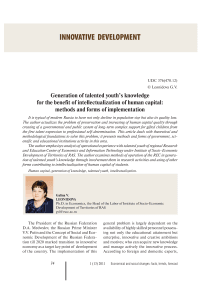Child population in Russia: main problems of development
Автор: Rimashevskaya Natalia Mikhailovna
Журнал: Economic and Social Changes: Facts, Trends, Forecast @volnc-esc-en
Рубрика: Social development
Статья в выпуске: 1 (13) т.4, 2011 года.
Бесплатный доступ
The article presents a comprehensive analysis of the problems of childhood in modern Russia, the relevance of which determine the severity of the socio-economic transformations of a society in which this part of the population is most vulnerable. At the same time investments in children's development - an investment in future human capital of the country. The results of this study allowed the author to highlight three laps problems associated with “the field of childhood”. First round - problems related to the scope, size and structure of children. The second set of problems related to analysis of conditions and institutions of formation of childhood. The third set of problems of the younger generation in Russia - is an unprecedented deterioration in health. Thus, the main objective of social policy is to improve the quality potential of children in the context of reducing their numbers. In the first place in this context is the task of improving health, from birth, followed by education and socialization throughout their internal relationship as a foundation for the development of system programs of public policy with regard to childhood.
Children's demographic crisis, the conditions and institutions of formation of childhood, reducing the number of children, the deterioration of child health
Короткий адрес: https://sciup.org/147223232
IDR: 147223232 | УДК: 316.346.3(470)
Текст научной статьи Child population in Russia: main problems of development
The President of the Russian Federation D.A. Medvedev, the Russian Prime Minister V.V. Putin and the Concept of Social and Economic Development of the Russian Federation till 2020 marked transition to innovative economy as a target key point of development of the country. The implementation of this general problem is largely dependent on the availability of highly skilled personnel possessing not only the educational attainment but enterprise, innovative and creative ambitions and motives; who can acquire new knowledge and manage actively the innovative process. According to foreign and domestic experts, human capital is more important resource than natural resources or cumulative wealth: they estimated that increasing of education by 1% leads to acceleration in the rates of GDP per capita by 3%1.
Growth of the process of informing of society and economy, rise in the volume of high-tech industry improve the quality of an intellectual component of human capital, i.e. its intellectualization.
Studying of the problem of human capital intellectualization primordially assumes researching of initial prerequisites for active work with gifted children and talented young people. It is an important condition to form the foundation of innovative economy. At the same time the public consciousness is required to adopt the following idea: in the demographic crisis gifted children provide a unique opportunity for Russian society to optimize the cost of reproduction expansion of the intellectual potential of the country. Looking for talented people is an objective need for achievement of the national progress. The flights of Soviet satellites served as incentive to search (by testing) and create the conditions for the maximum development of 35,000 talented senior high school students in the USA: at that time the Americans “put on the conveyor”, allocating annually about 1.5 billion dollars to develop talented persons2.
They established research centers under the universities to identify and educate gifted children, organized issue of special interest magazines (“Gifted Child Today”, “Educational Researcher”) and adopted the state program in 1990’s, particularly, “America – 2000. Learning strategy” (Goals 2000: Educate America Act)3.
Such government programs to identify and support gifted children and young people in their country and to attract the same people from other countries were developed in 1970s in all developed countries. The following international organizations were established: the World Council for gifted and talented children, which coordinates the work of their studying, training and education, organizes international conferences, as well as the European (“Eurotalant”, Russia is a member of this organization) and Asian Associations, which implement national programs, coordinate national projects, conduct international meetings, summer schools and competitions for gifted and talented pupils.
The Federal target program “Russian Children” and its subprogram “Gifted Children” have been implemented step-by-step since 1996 in Russia (fig. 1) .
Subjects of the Russian Federation use a variety of forms to support gifted and talented young people within the bounds of the subprogram: bonus funds, scholarships, competitions, festivals, conferences, etc.
These and other forms to support talented young people involve more than 3 thousand Russian schoolchildren from 8 – 11 grades; more than 5,000 pupils are trained in various areas of complementary education.
Normative legal base of working with gifted children has been developed and improved; financing of these purposes has been increased though it was too modest (fig. 2) . The program of State grants by the President of the Russian Federation is being implemented. However, there are many unsolved problems, particularly problems of use of transparent and competitive mechanisms for expenditures and identification of talented persons.
The following problems were being solved at the final fifth stage of the subprogram “Gifted Children” (2007 – 2010):
-
- creation of the state system of identification and development of gifted children and targeted support for children in accordance with their abilities also on the base of innova-
Figure 1. Implementation phases of the subprogram “Gifted Children” (Component part of the Federal target program “Russian Children”)
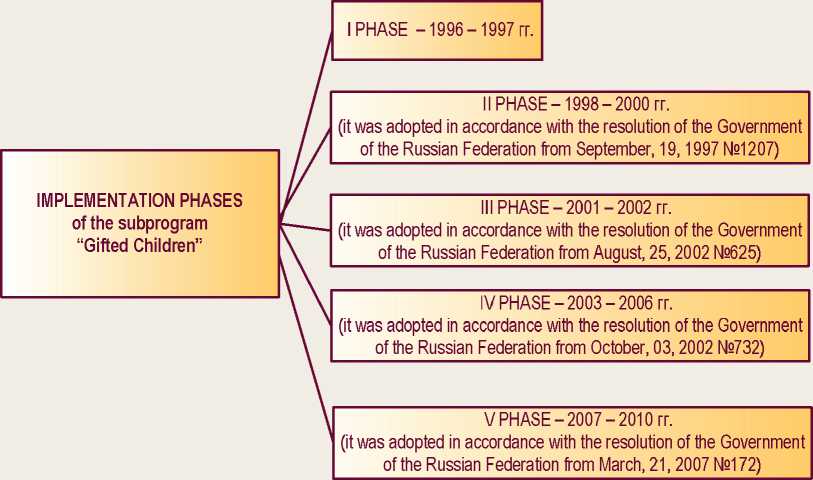
Figure 2. Financing of the subprogram “Gifted Children” by the federal budget, million rubles
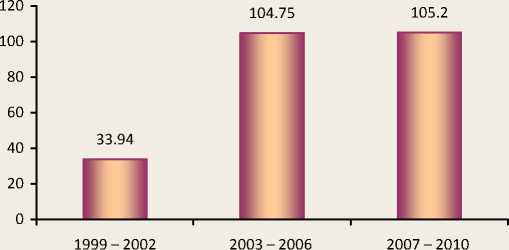
□ Amount of financing by the federal budget (million rubles)
Source: Sinyagina N.J., Kalish I.V., Zaitseva N.V. The implementation results of the subprogram “Gifted Children” of the Federal target program “Russian Children” in 2003 – 2006. – M., 2007. – 41 p.; Passport of the subprogram: “Gifted children”. – Resolution of the Government of the RF from January, 26, 2007№, 79 p.
tive technologies to identify and support gifted children living in the countryside and in the place which are situated far from the major centers of culture, education and science;
-
- coordination of activities of the basic centers working with gifted children and their support;
-
- consultant services for parents and teachers working with gifted children.
We will have to do a lot in all these areas. According to estimates of the Commission for the national intellectual potential of the Public Chamber of the RF it is necessary to renew our work with gifted children4 and to accelerate the creation of “giftedness infrastructure”.
Thereupon, it is crucial to know the difference between a gifted, talented child and other children. According to the most scholars, the gifted child usually has bright, obvious and sometimes outstanding achievements in different activities (or he has the internal prerequisites for such achievements)5. Giftedness is a quality which is developed systematically during our life, indicating the possibility of reaching by a person higher result in one or more types of activities.
Many psychologists recognize that the giftedness level, qualitative singularity and developmental character of giftedness are always the results of complex interaction of heredity (natural instincts) and social and cultural environment, that is mediated by the activities of a child (play activity, learning activity and labor activity). Giftedness can be recognized by a degree of the child’s advance in mental development as compared with his peers at other equal status.
Giftedness is regarded as a state of talent or a degree of talent intensity. When we spoke about ability we mean the possibility of a person to do something, but when we use a word “talent” we emphasize the innate nature of the quality (ability). At the same time both ability and talent become apparent in the successful activity.
One of the most important characteristics of giftedness is creativity. Tendency to creativity is the highest manifestation of human activity, the ability to create something new and original. This quality is of particular mindset, characterized by flexibility (the ability to move easily from one class of phenomena to other phenomena, whose content is often too different) and originality (the ability to suggest new and unexpected ideas which are differed from the conventional ideas).
Qualitative state monitoring of labor potential of the population in the region has been carried out by Institute of Socio-Economic Development of Territories of RAS in the Vologda Oblast since 1997. Its results show that the creativity index, calculated by the original methods6 (according to quotients of person’s relation to creative activity and his actual participation in creative activity), is the lowest among eight basic indices of social capacity (quality of labor potential). Moreover, its overall trend (in the dynamics from 1997 to 2009) is decreasing (tab. 1).
Low index of creative potential of the population is conditioned by the fact that only few people in the region are actively engaged in creative activity: about 8% of people always invent, write, compose, etc. and 45% of people do nothing”7.
The survey of students and senior pupils of different professional educational institutions8, which was conducted in Vologda in 2010, confirmed this regularity: only 10% of respondents were going to “realize themselves creatively” during their learning. The poll results also show that there are not enough conditions to develop creative potential of pupils and students. Thus, only 16% of senior pupils think that elective classes and study groups in their schools help them in learning good results and only 14% of pupils say about availability of in-depth subject programs. However, it should be noted that almost all high school students (97%) believe that it’s important for a modern man to develop creative and intellectual potential and they developed such qualities. Family influences greatly over pupils’ attitude to develop their creative abilities: parents of pupils, who seek to develop their creative and intellectual abilities (58%), have higher education or academic degree.
Table 1. Quality rating of labor potential of the population in Vologda oblast
|
Measurable indicators |
Index value |
Rank |
Trend line (from 1997 to 2009) |
|
|
1997 |
2009 |
|||
|
Moral level |
0.775 |
0.757 |
1 |
\ decreasing |
|
Mental health |
0.699 |
0.739 |
2 |
/ increasing |
|
Sociability |
0.733 |
0.736 |
3 |
– parallel to time axis |
|
Physical health |
0.682 |
0.728 |
4 |
/ increasing |
|
Standard of culture |
0.609 |
0.674 |
5 |
/ increasing |
|
Need for achievement |
0.612 |
0.643 |
6 |
/ increasing |
|
Cognitive potential |
0.630 |
0.614 |
7 |
\ decreasing |
|
Creative potential |
0.593 |
0.572 |
8 |
\ decreasing |
|
Integral index of labor potential quality |
0.655 |
0.674 |
/ increasing |
|
Source: Labor potential of the region: The final report of research / A.A. Shabunova, G.V. Leonidova, E.A. Chekmareva. – Vologda, ISEDT RAS, 2009. – 117 p. – № of official registration 02201051756.
Table 2. Distribution of the answers to the question: “What qualities does your current business require from you?” (Response category “Very important”, in % of respondents)
|
Qualities |
Year |
|||||
|
2004 |
2005 |
2006 |
2007 |
2008 |
2009 |
|
|
To be sociable, be able to be on good terms with other people |
36.8 |
40.2 |
42.2 |
38.6 |
39.4 |
37.6 |
|
To enjoy good physical health and to feel well |
38.7 |
34.7 |
37.0 |
37.9 |
41.7 |
36.9 |
|
To be hard to mental load |
27.8 |
30.1 |
38.1 |
34.7 |
35.4 |
36.6 |
|
To be a highly cultured person (to be a well-brought-up, polite, self-restrained and goodlooking person) |
29.9 |
30.5 |
32.0 |
31.4 |
33.1 |
32.2 |
|
To have high moral standards (honesty, truthfulness, sense of duty, decency, etc.) |
31.0 |
29.9 |
33.6 |
32.4 |
35.1 |
31.7 |
|
To have all-round knowledge, to be a man of great erudition, to be a highly skilled specialist |
23.4 |
27.9 |
28.7 |
26.3 |
28.1 |
25.9 |
|
To strive for promotion, to improve personal skills, to take the initiative and enterprise |
23.9 |
22.3 |
23.8 |
24.7 |
27.0 |
24.6 |
|
Have creative abilities (to invent, create the new, to solve previously unknown tasks, etc.) |
19.7 |
19.0 |
18.3 |
19.4 |
21.3 |
20.3 |
Source: Monitoring of labor potential quality of the population in Vologda oblast (total sample – 1500 people).
Creativity is a strategically important resource for innovative “smart” economy. However, according to the results of monitoring of labor potential quality, it is the least important quality for employers: only 20% of residents say that their creative abilities are demanded at their jobs (tab. 2) .
Development of people creative activity and the ability to resist social inertia takes place not only in schools but also in extracurricular supplementary education. According to the results of students’ opinion poll9, they regard the studies in the institutions of extracurricular education as one of the main sources of knowledge (tab. 3) .
The Soviet system of supplementary educational facilities for children and youth con- sisted of pioneer organizations, young technician’s stations, junior sports schools, etc. That system was an important component of Soviet education. It is significant that there were no such infrastructure in the Western countries earlier. That’s why Soviet education had competitive advantages. The crisis of 90’s affected the nursery and junior secondary education: the number of supplementary educational institutions was declined and as a result the total qualifying potential of the young Russians was decreased10. The number of supplementary educational institutions was increased only in the early 2000’s, including the Vologda oblast. They provide the formation of creative personality which is necessary for the knowledge-oriented economy.
Table 3. Distribution of the answers to the question: “How often do you use the following opportunities to enrich school knowledge?” (in %)
|
Opportunities |
Often and very often |
|
Using of Internet resources |
90.4 |
|
Reading of educational literature |
37.2 |
|
Study and hobby groups attendance in the institutions of extracurricular education |
34.0 |
|
Study and hobby groups attendance in school |
27.3 |
|
Visits to the libraries, museums, archive |
24.4 |
|
Source: Survey of students of comprehensive secondary schools in Vologda, the second quarter of 2010 (total sample – 156 people). |
|
Figure 3. Forms and trends of knowledge generation of talented youth in the Research and Educational Center under ISEDT RAS
FORMS OF WORKING WITH TALENTED YOUNG CHILDREN IN THE RESEARCH CENTER (VOLOGDA)

TYPES OF COMPETITIONS

v RESEARCH WORK
THE SYSTEM OF RESEARCH WORKS COMPETITIONS AT EVERY GRADE LEVEL
Research works competition among senior pupils
Students’ research works competition
Research works competition among young scientists
TYPES OF CONFERENCES
REPORT
SCIENTIFIC CONFERENCES FOR YOUNG SCIENTISTS
Conference for senior pupils of REC “Economics from the senior pupil’s point of view” Student conferences “New Economics - New Society”
“Economy of the region: reality and prospects” Conference for young scientists “Young scientists to economy of the region”
PREPARATION OF REPORTS TO TAKE PART IN REGIONAL, RUSSIAN, INTERNATIONAL COMPETITIONSAND CONFERENCES IN THE TRENDS OF: ECONOMICS AND
MANAGEMENT
TYPES OF COLLECTED ARTICLES
DEVELOPMENT OF RESEARCH QUALITIES AND CREATIVE SEARCHING SKILLS
PUBLICATION
Publication of a collected competitive articles of young scientists
Collection of “Economics from the senior pupil’s point of view”
Collections of “New Economics - New Society”,
■► “Economy of the region: reality and prospects” Collection of “Young scientists to economy of the region”
FORMING OF PERSONAL INTELLECTUAL POTENTIAL
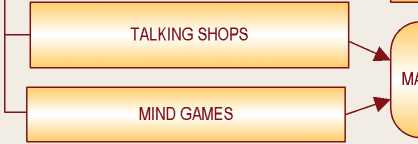
DEVELOPMENT OF LEADERSHIP AND JAGERIAL QUALITIES AS WELL AS ABILITY TO WORK IN A TEAM
Research and Education Center of Economics and Information Technology under ISEDT RAS (it was established in 2003) creates such conditions for training and education as early detection, training and education of gifted and talented children. The Center represents a
Table 4. The activity indicators of the REC under ISEDT RAS in 2002 – 2010
Creating of the Research and Education Center under the basis of academic research institution in Vologda organizators thought that its main mission would be creating of conditions for detection of talented young people in the region, development of their abilities and involvement them into scientific sphere, reconstruction of the scientific inquiry environment.
Activity of the Research and Education Center is built in such a way that it is possible to use those forms that are the most productive ways to work with talented youth. Their specific structure is shown in figure 3 .
The priority direction of selection and identifying of talented young people by force of the Research and Education Center is involvement each of them in research activity. Moreover, it is considered, on the one hand, as a way to improve efficiency of digestion of knowledge and skills of relevant educational standards and further generation, i.e. increment of knowledge, on the other – as a way to initial professional training. Just that very context sets the goal of selecting of talented and motivated children with subsequent profiling of their education and orientation to work in high-tech industries.
Realization of the REC’s goal is based on the contemporary theoretical and methodological approaches; the main of them are continuing education (learning throughout life), connection between theory and practice (knowledge, gained in the REC, are used in specific scientific researches, research results of scientists are used in teaching special subjects, in preparation of teaching aids, etc.), continuity of educational programs, etc.
The feature of the educational process in the Research and Educational Center is using of diverse techniques, active training forms and methods based on the following principle: knowledge (in-depth study of economical foundations) and ability to apply them (applying of the skills by the use of approved research results, research efforts competitions, presentations at school conferences, participation in the discussions, etc.).
In addition to traditional forms promoting all-round development of trainee’s skills the REC also uses the following forms to work with the young people:
-
• talking shops;
-
• mind and business games;
-
• profile health camps (summer research schools) on holidays, etc.
The main quantitative indicators of the REC activity are represented in the table 4 .
But quantitative parameters are only the first side in the evaluation of the REC’s activity. The annual studies of intellectual and professional abilities of students have significant practical importance for understanding of the Research and Education Center’s role in knowledge generation of talented young people11. Testing results show that the values of
Figure 4. The dynamics of answers to the question: “What are the main benefits of your training in the REC?” (in% of respondents)
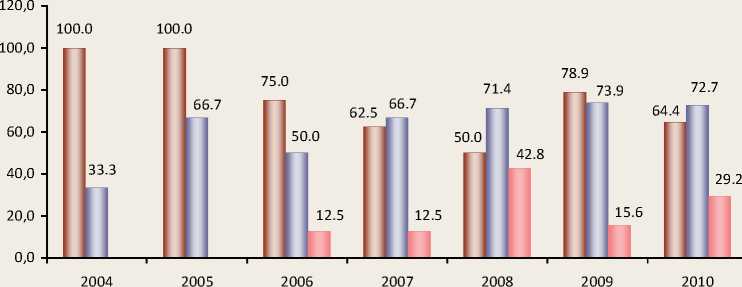
□ In-depth economic backgrounds □ Researching knowledge and skills п Ability to appear before a audience
the intellectual sphere12 (erudition, vocabulary, abstract logic, attention13) increase by the end of training (from the 5th to 11th grade) as compared with the beginning of training in the REC by 2 or 3 points on ten-point scale (for example, mean value in the 11th city-wide grade was 5.6 points in 2008, it was 6.3 points in 2009 and 7.1 points in 2010). Consequently, there is a marked increase in intellectual capacity of the students who attend classes at the REC.
The REC’s staff uses V.M. Rusalova techniques as a tool to identify the skills, qualities and properties required to form a research position. According to the techniques you can judge about personality’s expression by such indicators as subject ergicness (a flair for intense mental labor), social ergicness (a desire to explore the world through communication)
and flexibility (a desire to diversify the forms of subject activities). Survey results show that all students have the positive dynamics of the flair for intense mental labor (for example, the senior students from the Lyce №32 who attend the REC had a mean value of “subject ergicness”, i.e. the flair for intense mental labor, amounted to 6.9 points in 2008, 7.1 points in 2009 and 8,4 points in 2010). It is evidence of the fact that studies in the Research and Educational Center under ISEDT RAS increase the interest of students to research activity. According to students’ opinions the main advantages of education in the REC are getting of in-depth economic backgrounds and learning of researching skills (fig. 4) .
The REC’s project is aimed to create conditions for personal and vocational realization of talented youth, it should improve the system of training and retraining of scientific, managerial and engineering personnel. The REC provides continuity of educational process in the chain of “school – university – postgraduate education”. The best pupils of the REC can join the student groups by economic specialties in the branch of St. Petersburg State Engineering and
Table 5. The results of entering the universities of graduating seniors from the full-time elective class in the REC under ISEDT RAS
|
Indicators |
2008/09 ac. year |
2009/10 ac. year |
||
|
Total |
% |
total |
% |
|
|
Number of graduating seniors, total |
41 |
100 |
42 |
100 |
|
Number of graduating seniors who entered the universities |
41 |
100 |
42 |
100 |
|
Number of graduating seniors who entered the universities of Vologda |
31 |
76 |
36 |
86 |
|
Of them: Vologda State Technical University |
11 |
27 |
15 |
36 |
|
Vologda State Teacher’s Training University |
3 |
7 |
8 |
19 |
|
St. Petersburg State Engineering and Economic University, a branch in Vologda |
6 |
15 |
3 |
7 |
|
Vologda State Milk and Economical Academy named after N.V. Vereshchagin |
3 |
7 |
8 |
19 |
|
Moscow State Law Academy, a branch in Vologda |
6 |
15 |
0 |
0 |
|
Vologda Institute of Economics and Law FSEP RF |
1 |
2 |
2 |
5 |
|
Educational institutions in St. Petersburg |
5 |
12 |
5 |
12 |
|
Educational institutions in Moscow |
2 |
4 |
1 |
2 |
Economic University in Vologda (one of the participants of the Research and Education Center; tab. 5 ).
This table shows that most of graduating seniors from the Research and Educational Center remain in the region, they prefer the regional universities that prevents “brain drain”. This situation is good for the region where level of scientific and technological capacity is low.
The project shows a high degree of effectiveness. Young scientists, postgraduate students, students and pupils often become winners and laureates of the regional, national and international competitions. The project has a great social significance: it has created favorable environment for display of creativity and personal development of gifted and talented youth. The project is supported by the Russian Academy of Sciences, regional and local authorities, the Ministry of Education and Science of the RF. The project got approval and support of the President of the Russian Federation in 2003.
Such work is possible thanks to the activities aimed to identify and support talented researchers and promote their creative growth. They are organized by the Russian Academy of Sci-ences14 in the framework of the Supporting program for young scientists.
Pedagogical literature15 demonstrates convincingly that talented people are often in the shade wrongly. And there will be a negative selection in the society if we do not create a system that draws talent from the shadows. Therefore, it is highly important to create a competitive environment in science, business and art16. Various modern sponsoring funds correspond to these goals. It is necessary to extend the experience of innovative schools: physics and mathematics schools (for example, gymnasium “Harmony” in Vologda), schools of Olympic reserve, special music schools, business schools, etc.
However, the task of supporting of talented children assumes the construction of the statepublic system of long-term complex support for gifted children from the first display of talent to the professional self-determination. The concept of the national educational initiative “Our New School”, voiced at the summit in 2010, is a base to create a complex system of supporting and looking for gifted children, as well as their support during the period of making up of personality. State support for talented children and youth is the only reliable method of reproduction of the national intellectual elite and the most important intellectualization factor of the human capital in the country.
Thus, the regional Research and Education Center helps to solve the problem of search and development of gifted children in the country. Its effectiveness can be increased by passing the regional laws, subordinate acts and target programs, by making interdepartmental con- tracts, industry-wide agreements and other documents. It is also necessary to report the problem of gifted children development by mass media within the scope of action consolidation of the regional educational system and research institutions.
Список литературы Child population in Russia: main problems of development
- Antonov, A.I. The population dynamics of Russia in XXI century and the priorities of the demographic policy/A.I. Antonov, V.A. Borisov. -M.: Key-C. -2006. -P. 57.
- Amosov, N.M. Amosov's Encyclopedia. Algorithm of health/N.M. Amosov. -M: AST; Donetsk: Stalker. -2005.
- Galetsky, V.F. Demographic transition and family transformation. Coll. Present and future of demographics of Russia through the prism of population censuses (1897, 2002 and 2010). Reports of the international scientific-practical conference/V.F. Galetsky. -M: SU IMEI, 2007. -P. 63.
- Tender stereotypes in a changing society: experience of an integrated social studies/edited by N.M. Rimashevskaya (scientific ed.). -M.: Science, 2009. -P. 270.
- Giddens, A. Sociology/A. Giddens. -M.: Editorial URSS, 1999. -P. 672.
- Gorbunov, N.P. Functional status of school children in adapting to the learning activity/N.P. Gorbunov//Pedagogy. -2003. -№ 8. -Pp. 9-12.
- State Report “On the situation of children in the Russian Federation” M.: BEST-print, 2006. -150 p.
- Gurko, T.A. Parenting as a socio-cultural phenomenon: abstract of the doctoral thesis/T.A. Gurko. -M.: Institute of Sociology of RAS, 2008.
- Eger, V. Social change in sociological theories of modernity/V. Eger, H.I. Mayer. -Smolensk: SmolGU, 2007.
- Zakharov, S. One generation can live many lives /S. Zakharov. -Access mode:http://demoscope.ru/weekly/2005/0193/analit05.php
- Zdravomyslova, O.M. Russian family on the European background/O.M. Zdravomyslova, M.Yu. Arutyunyan. -M.: Editorial URSS, 1998.
- Zdravomyslova, O.M. Family and society: the gender dimension of the Russian transformation/O.M. Zdravomyslova. -M.: Editorial URSS, 2003.
- Zdravomyslova, E.A. Baby sitters: commercialization of care/E.A. Zdravomyslova//The new way of life in modern Russia: tender studies of everyday life. -Spb.: European University at St. Petersburg, 2008. -Pp. 100-101.
- Zielinskaya, D.I. Adolescents disability in the Russian Federation/D.I. Zielinskaya, R.N. Terleshchaya//Information analytical bulletin. Social aspects of population's health. -2008. -№ 4 (8).
- Kapelyushnikov, R. Is human capital appreciated in the Russian labor market? /R. Kapelyushnikov. -Access mode: http://demoscope.rU/weekly/2005/0193/temaO I. php
- Kislitsyna, O.A. Major trends in the health state of Russian children and teenagers/O.A. Kislitsyna//Economy of cities and regions. -2009. -№ 4 (29).
- Availability of quality general education in Russia: opportunities and limitations /D.D. Konstantinovsky, V.S. Vakhshtayn, D.Yu. Kurakin, Ya.M. Roshchina//Education Issues. -2006. -№ 2. -Access mode: http://vo.hse.ru/arhiv.aspx?catid=252&z=367&tno=368&obпо=468
- Korsak, V.S. Russian National Register VRT. Summary Report for 1998/V.S. Korsak//Problems of reproduction. -1999. -№ 1. -P. 8.
- Kudryavtsev, V.N. Modern problems of crime control in Russia /V.N. Kudryavtsev//RAS Bulletin. -1999. -№ 9. -Access mode: http://vivovoco.rsl.ru/VV/JOURNAL/VRAN/CRlME.HTM
- Kuzminov Ya. Education -that is our national idea /Ya. Kuzminov. -Access mode: http://www.school.edu.ru/news.asp?ob_no=3528
- Lapin, N.I. How do the citizens of Russia feel, what do aspire to/N.I. Lapin//Sotsis. -2003. -№ 6. -Pp. 78-87.
- Magun, V. Dynamics of claims and change of resource strategies of the youth (1985 -2005) /V. Magun, M. Engovatov. -Access mode: http://demoscope.ru/weekly/2008/0345/analit01.php
- Matyushkin, A.M. Gifted and talented children/A.M. Matyushkin, D.A. Sisk//Problems of Psychology. -1988. -№ 4. -P. 90.
- Review of social policy in Russia, early 2000's/ed. by T.M. Maleeva. -M.: NISP, 2007.
- Education and Society: Is Russia ready to invest in its future?/Report of the Public Chamber of the Russian Federation (2007) //Education Issues. -2007. -№ 4. -P. 9. -Access mode: http://vo.hse.ru/arhiv.aspx?catid=252&z=710&t_no=71l&ob_no=712
- Omelchenko, E. The effectiveness of CT: an attempt of sociological analysis /E. Omelchenko, E. Lukyanova. -Access mode: www.ulsu.ru/7main-issues&sub=vestnik&anunr=
- Health care problems of the child population in Russia/A.I. Potapov, V.N. Rakitskiy, N.I. Novichkova, E.A. Romanova//Health care of the Russian Federation. -2008. -№ 3. -Pp. 3-5.
- Press-release № 1236 ARPORS dated June 1, 2009 . -Access mode: http://wciom.ru/novosti/press-vvpuski/press-vvpusk/single/11941.htm
- Rimashevskaya, N.M. Social values, market and education/N.M. Rimashevskaya//Human Population. -2008. -№ 1. -P. 8.
- Monitoring of the younger generation: trends and patterns of development/N.M. Rimashevskaya, E.B. Breeva, R.T. Barsukova, A.A. Shabunova//Human Population. -2007. -№ 1.
- Rybakovsky, L.L. Features of the present demographic situation. Demographic prospects of Russia/ed. by G.V. Osipov, S.V. Ryazantseva. -M.: Econ-Inform. -2008. -P. 95.
- Families with children in today's Russia: economic and social portrait: collective monograph/ed. by L.N. Ovcharova and L.M. Prokofiev. -M.: ISESP RAS, 2008. -P. 9.
- Smakotina, N.L. Basics of instability sociology and risk: sociological, philosophical and social-psychological aspects/N.L. Smakotina. -M.: KDU, 2009.
- Statistical Yearbook of the Russian Federation: stat.coll./Rosstat. -M., 2007.
- Statistical Yearbook of the Vologda oblast: stat.coll./Vologdastat. -Vologda. -2008.
- Frumin, I.D. Main approaches to the problem of equality of educational opportunities /I.D. Frumin//Education Issues. -2006. -№ 2. -Access mode: http://vo.hse.ru/arhiv.aspx?catid=252&z=367&tno=368&obno=369
- Shurigina, I.I. The influence of teenagers family's social status on their attitudes to various forms of deviant behavior/I.I. Shurigina//Family in Russia. -1999. -№ 1/2.
- Should ART be part of a population policy mix? A Preliminary Assessment of the Demographic and Economic Impact of Assisted Reproductive Technologies/J. Grant, S. Hoorens, F. Gallo, J. Cave//RAND Europe. -2006.
- Tung, R.L. Brain circulation, diaspora, and international competitiveness./R.L. Tung//European Management Journal. -2008. -№ 26. -300.

